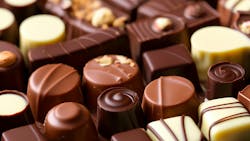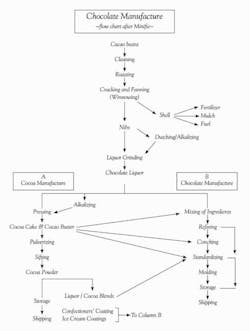Chocolate: From Theology and Processing to Functional Food
With Easter just behind us and chocolate consumption hitting its second-quarter 2025 peak, it’s a good time to reflect on the theological and processing developments that have got us where we are today.
From Sacred Sips to Sweet Treats
Most historians accept that Spanish explorers introduced chocolate to Europe in the 1500s after they saw Aztecs drinking a thick concoction made of ground cocoa beans and fermented corn whipped to a froth.
By the late 1600s, it was a favorite with pretty much every royal and wealthy family on the continent.
However, the penchant for the elite to drink it during long church services prompted devout Catholics to worry that fasting rules were being broken.
Not so, declared Pope Pius V in 1569, adding that the hot liquid tasted foul.
So, the faithful (and not so faithful – Queen Elizabeth I was a noted chocoholic) continued quaffing until the rise of the great chocolate processors in the 1800s.
Breakthroughs That Shaped the Bar
The first breakthrough came in 1828 when Dutch inventor Casparus van Houten patented a method for pressing the natural fat, known as cocoa butter, out of roasted cocoa beans.
The center of the bean, known as the nib, contains an average of 54% cocoa butter. Previously, hot chocolate was very fatty and quite dense and, according to craft cocoa supplier Cocoa Runners, a noted hazard for bearded consumers.
After drying, chocolate liquor from van Houten’s press was finely ground into unsweetened cocoa powder.
A few years later his son Coenraad invented a process known as Dutching. Here, the cocoa powder is washed with a potassium carbonate solution which neutralizes its natural acidity and gives a milder flavor.
As well as preserving beards, the isolation of cocoa butter helped J.S. Fry & Sons, Bristol, U.K., create the world’s first solid chocolate bar in 1847.
Joseph Fry, a Quaker, patented a process that linked a hydraulic press to a Watt steam engine. By mixing finely ground cocoa powder with sugar and previously extracted cocoa fat, it formed a paste that could be molded into a dark (plain) chocolate bar.
Milk chocolate posed different processing challenges, which Swiss chocolatier and entrepreneur Daniel Peter spent almost 30 years trying to crack.
He first added milk to chocolate in 1857, but the milk's water content made the product soft and prone to mildew.
Luckily, his neighbor and baby food manufacturer, Henri Nestlé, had invented a milk condensation process that could be adapted for the task. Even so, it took years of experimentation and fine-tuning before Peter’s product hit the market in 1887.
While Peter was battling with condensation issues, fellow Swiss chocolatier and inventor Rodolphe Lindt further improved the quality of chocolate with the invention of conching in December 1879.
Here, a surface scraping mixer and agitator, known as a conch because of its similarity in shape to the massive mollusk, evenly distributes cocoa butter within chocolate to improve texture. The friction involved drives off unwanted volatiles and so improves flavor.
Like Fry, Lindt also reintroduced cocoa fat into the mixture and this, combined with conching, gave Swiss chocolate its much sought-after mild, rich taste.
Back in the U.K., also in 1879, another Quaker company by the name of Cadbury was producing the first milk chocolate bars there. A third U.K. Quaker company, Rowntree, used van Houten-press-related technology to produce its own milk chocolate block in 1899.
In the United States, Hershey launched its first milk chocolate bars in 1900 and went on to pioneer mass production and methods to extend product shelf life.
A flow diagram published in Bernard Minifie’s book “Chocolate, Cocoa and Confectionery: Science and Technology” pulls together pretty much everything involved in the process. (Figure 1).
Modern Takes on a Classic Treat
So, how many types of chocolate are available in 2025?
Chocolate manufacturer and cocoa grower Hotel Chocolat lists eight, with supermilk, ruby, nutmilk, blonde and 100% dark chocolate added to the original trio of dark, milk and white (itself pioneered in the 1930s by the company founded by Henri Nestlé). Others list from three to 13.
Another development is finding the raw ingredient in products as diverse as cocktails, vegan fudge and salad dressings.
Its latest incarnation is as a potential health food. A report in ACS Food Science & Technology on March 13 suggests that packing chocolate with pre- and probiotics could boost its health benefits.
The goal of this, says report co-author and functional food expert Smriti Gaur, associate professor with the Department of Biotechnology, Jaypee Institute of Information Technology, Noida, India, is to create an even more wholesome and enjoyable treat.
Reference: The Rest is History - The History of Chocolate Explained
About the Author
Seán Ottewell
Editor-at-Large
Seán Crevan Ottewell is Chemical Processing's Editor-at-Large. Seán earned his bachelor's of science degree in biochemistry at the University of Warwick and his master's in radiation biochemistry at the University of London. He served as Science Officer with the UK Department of Environment’s Chernobyl Monitoring Unit’s Food Science Radiation Unit, London. His editorial background includes assistant editor, news editor and then editor of The Chemical Engineer, the Institution of Chemical Engineers’ twice monthly technical journal. Prior to joining Chemical Processing in 2012 he was editor of European Chemical Engineer, European Process Engineer, International Power Engineer, and European Laboratory Scientist, with Setform Limited, London.
He is based in East Mayo, Republic of Ireland, where he and his wife Suzi (a maths, biology and chemistry teacher) host guests from all over the world at their holiday cottage in East Mayo.


